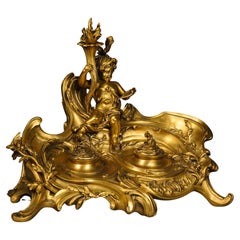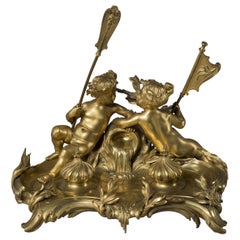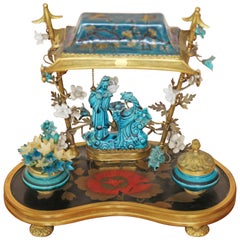A very rare and important exhibition encrier by François Linke and Léon Messagé.
French, circa 1900.
Index number 709.
Signed to the edge 'F. Linke'.
This exceptional and ambitious encrier is modelled as two putti, each holding a standard and sitting on the water's edge, the two inkwells with hinged spirally-fluted covers with glass liners.
This important inkwell is based on Léon Messagé's celebrated sculptural group 'La Source' and was originally intended by Linke to form part of his spectacular Stand at the 1900 Paris Exposition Universelle. Like seven or eight other pieces originally intended for inclusion on the Stand, it would seem the encrier was a casualty of both Linke's over-ambitious production schedule and the financial burden that the manufacture of such ornate and high quality work imposed. It was eventually shown on the Stand in September after the gilding was finished by Picard at a cost of 90 French francs. The costs of the model were very high: some 2024 francs (of which Message's combined fee was 1158 francs 40 centimes), underlining the originality and complexity. The 1900 Exposition example was sold, along with three important pieces of furniture from the Stand (the Grand bureau and associated armchair, and the Bahut Louis XV Mars et Vénus), to the South African banker and diamond merchant Solomon Joel. A further six encriers were produced up until 1925.
Object Literature:
Payne, Christopher. François Linke, 1855-1946, The Belle Époque of French Furniture, p. 90, pl. 97; p. 149, pl. 157; p. 150; pp. 182-183, pls 197 & 198 as exhibited at the Liege exhibition in 1905 & p. 480 for the original notes in Linke's Blue daybook of the late 1890s.
François Linke (1855 - 1946) was the most important Parisian cabinet maker of the late nineteenth and early twentieth centuries, and possibly the most sought after cabinet maker of his period.
He was born in 1855 in the small village of Pankraz, in what is now the Czech Republic. Records show that Linke served an apprenticeship with the master cabinetmaker Neumann, then in 1875 at the age of 20 he arrived in Paris where he lived until he died in 1946.
It is known that the fledgling Linke workshops were active in Paris in the Faubourg St. Antoine as early as 1881, and during this time he supplied furniture for other more established makers such as Jansen and Krieger.
The quality of Linke's craftsmanship was unsurpassed by any of his contemporaries and reached its peak with his spectacular Stand at the Paris Exposition Universelle in 1900, where his Grand Bureau took the Gold Medal. He gambled his fortune and reputation on this Stand, exhibiting several breathtaking items of furniture with sculptural mounts of the most exceptional quality and proportion. His gamble worked and his reputation was established to such an extent that Linke continued to be the pre-eminent furniture house in Paris until the Second World War.
As the Art Journal reported in 1900 on Linke's Stand:
'The work of M. Linke ... was an example of what can be done by seeking inspiration amongst the Classic examples of Louis XV and XVI without in any great sense copying these great works. M. Linke's work was original in the true sense of the word, and as such commended itself to the intelligent seeker after the really artistic things of the Exhibition. Wonderful talent was employed in producing the magnificent pieces of furniture displayed....'
The formation of Linke's distinctive style was made possible by his collaboration with the sculptor Léon Messagé.
Together Linke and Messagé designed furniture for Linke's 1900 exhibition Stand, with exuberant allegorical figures cast in high relief, that exemplified Linke's ability to seamlessly merge the different mediums of wood carving, bronze and marquetry into a dynamic unified whole.
Today Linke is best known for the exceptionally high quality of his work, as well as his individualism and inventiveness. All of his work has the finest, most lavish mounts, very often applied to comparatively simple carcasses. The technical brilliance of his work and the artistic change that it represented were never to be repeated.
Bibliography:
Payne, Christopher. François Linke, (1855 - 1946), The Belle Époque of French Furniture, Antique Collectors' Club, (Woodbridge, UK), 2003.
Meyer, Jonathan. Great Exhibitions - London, New York, Paris, Philadelphia, 1851-1900, Antique Collectors' Club, (Woodbridge, UK), 2006; pp. 298 - 300.
LeDoux - Lebard, Denise. Les Ébénistes du XIXe siècle, Les Editions de l'Amateur, (Paris), 1984; pp. 439-43.
Revue Artistique & Industrielle, (Paris), July-August 1900.
Coral Thomsen, D. (ed), The Paris Exhibition 1900, The Art Journal, 1901; p.341.
Léon Messagé (1842-1901) had a brilliant, but short lived career. He is best known for his incredible sculptural collaboration with François Linke for the 1900 Paris Exposition Universelle. A gifted sculptor, Messagé was also responsible for much of the design and creative work for Roux et Brunet and Joseph-Emmanuel Zwiener.
Messagé enjoyed great success as a designer/sculptor before his collaboration with Linke. Indeed he was mentioned as a Gold Medal winner at the 1889 International Exhibition and was especially praised for his work on a cabinet by Zwiener. He came into contact with Linke in 1885 and it appears from then on Linke employed him on a regular basis.
Messagé was primarily influenced by Rococo ornament but he strove to re-interpret it. He did not produce slavish copies, and his original approach can be appreciated in Linke's celebrated Grande Bibliothèque and Grand Bureau exhibited at the 1900 Paris Exposition Universelle. A number of drawings by Messagé are recorded and after his success at the exhibition of 1889 he was encouraged to publish his designs.
'
Cahier...



